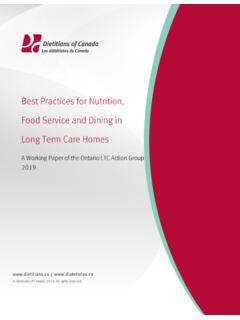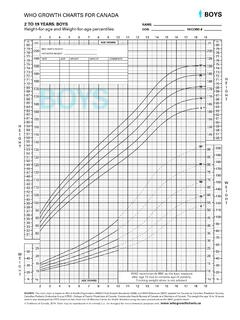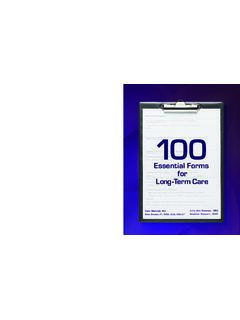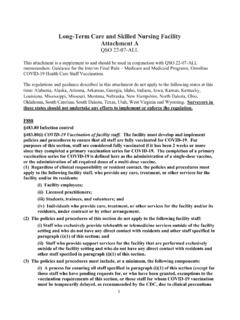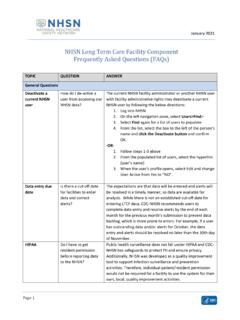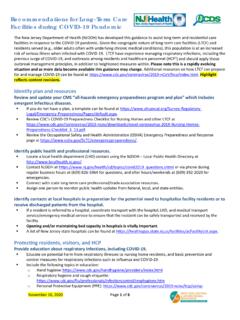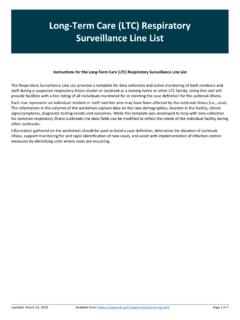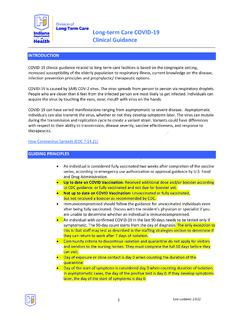Transcription of MENU PLANNING In Long Term Care - Dietitians of Canada
1 menu PLANNING In long Term care And Canada s Food Guide (2019) JULY 2020 Dietitians of Canada , OPDQ and CNS/CMTF 2020. All rights reserved. menu PLANNING IN long TERM care WITH Canada S FOOD GUIDE (2019) i Dietitians of Canada , OPDQ and CNS/CMTF 2020. All rights reserved. TABLE OF CONTENTS 1 Highlights .. 2 Purpose .. 3 Background .. 4 Profile of long Term care Residents .. 5 Importance of menu PLANNING and a Food First Approach .. 6 Canada s Dietary Guidelines (2019) and Recommended Modifications for LTC .. 7 Overall Recommendations for LTC menu PLANNING .. 11 Nutrient Analysis of menu .. 14 Questions and Answers .. 15 Overall menu PLANNING Q&A .. 15 Protein Foods Q&A .. 19 Vegetables and Fruits Q&A .. 22 Whole Grain Foods Q&A .. 23 Fats Q&A .. 24 Beverages Q&A .. 24 Policy Recommendations to Support Effective Food Provision in LTC .. 26 References .. 27 Appendices .. 30 Appendix 1: CFG Requirements in Provincial Regulations and Standards.
2 30 Appendix 2: RDA/AI for Older Adults and Food Sources .. 32 Appendix 3: Sample menu Pattern .. 35 Appendix 4: Sample menu Audit Tool .. 37 Appendix 5: Gordon Food Service menu Plating Experiment .. 39 1 Dietitians of Canada , OPDQ and CNS/CMTF 2020. All rights reserved. ACKNOWLEDGEMENTS Dietitians of Canada convened a group of engaged Dietitians from across the country to discuss the impact of the 2019 version of Canada s Food Guide (CFG) as they relate to LTC menu PLANNING . L Ordre professionnel des di t tistes du Qu bec (OPDQ) and Canadian Malnutrition Task Force (CMTF) noted similar concerns and engaged in joint development of this guidance. Health Canada and provincial government departments involved in inspecting and licensing LTC homes were made aware of the project. This project was a collaborative effort by numerous authors and reviewers. Special thanks to these contributors: Sharon Armstrong Melissa Arsenault Marlin Bendayan Sandi Berwick Karen Boyd Paule Bernier Jodi Crawford Sarah Faulds Cherie Furlan-Craievich Gordon Food Service Nutrition Resource Centre Denise Hackett Robin Hartl Kristen Hayes Jean Helps Jenna Hope Michele Keeling Heather Keller Dale Mayerson Julie McNeil Seshni Naidoo Jo-anna Pollard Mary Popovich Meghan Rowe Kate Shaw Janice Sorensen Karen Thompson Leslie Whittington-Carter 2 Dietitians of Canada , OPDQ and CNS/CMTF 2020.
3 All rights reserved. HIGHLIGHTS Over 200,000 individuals live in long term care (LTC) residential homes in Canada and many other older Canadians live in supportive and retirement/assisted living. This document is intended primarily for facilities providing 24-hour care to frail elderly with functional and/or cognitive limitations that increase risk of malnutrition. WORKING WITH THE MEDIA This guidance document is: Intended to assist Registered Dietitians , Nutrition Managers and menu planners to prepare a cycle menu to meet LTC residents overall nutritional needs. Not intended as a complete guide to menu PLANNING in LTC, which is a complex process requiring foundational knowledge in nutrition, food production, culinary skills, and geriatrics as well as operation-specific knowledge of the clientele and operational capacity. Menus for LTC homes Must be based on in-depth knowledge of the residents preferences and needs.
4 Should meet Dietary Reference Intakes (DRIs) standards for ensuring nutritional quality, establishing required quantities of specific nutrients that should be offered on a daily basis. A food first approach is recommended, where the menu items provided meet the nutritional needs of the majority of the residents, and nutrient-dense foods and beverages are used to meet individual needs. Nutrient-dense refers to menu items that are high in nutritional quality relative to the portion size. menu reviews and analyses based on actual food production (recipes and purchased products) and dining service practices in the LTC home are needed to ensure accuracy. 3 Dietitians of Canada , OPDQ and CNS/CMTF 2020. All rights reserved. PURPOSE This guidance document is not intended to be a complete guide to menu PLANNING . menu PLANNING is a complex process that requires knowledge of nutrition, geriatrics, culinary skills, and food production.
5 menu planners are expected to have the foundational knowledge to develop a varied menu for regular diets as well as texture modifications, and nutrition interventions for individualized care . All menus must be based on in-depth knowledge of the residents preferences and needs. It is recognized that interpretation and judgement on whether a menu is meeting provincial/territory requirements is ultimately the role of the provincial/territorial government. This guidance document is intended to support menu PLANNING but cannot replace legislative authority. (See Policy Recommendations to Support Effective Food Provision in LTC). 4 Dietitians of Canada , OPDQ and CNS/CMTF 2020. All rights reserved. BACKGROUND Historically, LTC menu PLANNING has complied with guidance as provided by Canada s Food Guide (CFG) and provincial/territorial standards and regulations. (See Appendix 1 CFG Requirements in Provincial Regulations and Standards that refer to use of CFG to plan menus.)
6 In 2019, Health Canada released an updated version of CFG. (1) During the extensive consultative process, Dietitians of Canada , CMTF, OPDQ and other groups noted that CFG lacks specificity for institutional environments, including long term/residential care (LTC), related to the vulnerability of these populations that are often frail, at nutrition risk, and/or malnourished. People residing in LTC often have multiple conditions and require complex care . Other countries ( Australia, Denmark) have recognized the need to adapt population level dietary guidance for residential care , and frail elderly. (2)(3)(4) Although specific guidance for older adults in LTC is not provided in CFG, Canada s Dietary Guidelines 2019 recognize that older adults can be vulnerable to poor dietary intake, which is affected by physiological changes, such as poor oral health, diminished appetite, sensory changes, altered digestive processes, chronic health issues, and the effects of medication.
7 The Dietary Guidelines further note that Individuals with specific dietary requirements, including those receiving care in a clinical setting, may need additional guidance or specialized advice from a dietitian. (1) CFG and Canada s Dietary Guidelines are intended to provide an overall pattern of eating but were never intended to provide a rigid application of daily menu servings. CFG 2019 aims to reduce risk of diet-related chronic diseases and conditions including obesity, cardiovascular disease, type 2 diabetes, certain types of cancer and osteoporosis. (1) This is in stark contrast to the primary nutrition issues of concern in LTC of malnutrition and management of chronic diseases. CFG is noted in many of the provincial standards for menu PLANNING in LTC (see Appendix 1). The previous versions of CFG included serving sizes and recommended number of servings from each food group, which were used to plan and evaluate menus in health care institutions ( 7 servings of grains, 2 3 servings of meat and alternatives, etc.)
8 CFG 2019 does not include the same specific serving recommendations. Menus planned with the 2007 version of CFG resulted in a common observation among providers that the volume of food being provided to residents was often much larger than they could consume, resulting in extensive food waste and increased costs. (5) Since CFG 2019 is less prescriptive, there is more flexibility to meet nutritional needs and preferences in a smaller volume of food. 5 Dietitians of Canada , OPDQ and CNS/CMTF 2020. All rights reserved. PROFILE OF long TERM care RESIDENTS Over 200,000 individuals live in LTC in Canada and many other older Canadians live in supportive and retirement/assisted living. (6) There is a range of age and functional capacity of adults living in long term care ; some residents are focused on rehabilitation or maintenance of function, and promotion of health is relevant, while others are at the end of life where quality of life is paramount.
9 A typical Canadian LTC resident is: - 80+ years of age - likely to have dementia (62% of residents diagnosed, 32% with severe cognitive impairment) - likely to have neurological conditions ( 20% of residents CVA/stroke, 6% Parkinson s disease) - diagnosed with health conditions with specific dietary requirements ( 26% diagnosed with diabetes, 22% with gastrointestinal diseases, 10% with renal disease) (6) Common nutritional challenges in this population include: - malnutrition - constipation - digestive problems - dysphagia - poor dentition - dementia - dehydration - pressure injuries - challenges with independently eating due to functional or cognitive limitations - food allergies/intolerances - diminished appetite - need for therapeutic diets and/or modified textures All of these challenges result in increased risk of protein-energy malnutrition, and micronutrient inadequacy. (7) These are key variables that impact food intake and can be managed by appropriate general menu PLANNING and individualized nutrition care interventions.
10 (8)(9) 6 Dietitians of Canada , OPDQ and CNS/CMTF 2020. All rights reserved. IMPORTANCE OF menu PLANNING AND A FOOD FIRST APPROACH LTC provides a supportive social and healthcare environment that promotes the maintenance of function and health. Quality of life drives care in these settings. A food first approach is recommended, where the menu items provided meet the nutritional needs of the majority of the residents, and nutrient-dense foods and beverages are used to meet individual needs. (13) A food first approach is intended to meet nutrient needs, instead of or in addition to oral nutritional supplements (ONS), such as Ensure or Resource , or individual nutrient supplementation. Regular use of ONS may contribute to compensatory reduced food intake and residents may tire of the available flavours. (10) A menu based on nutrient-dense, culturally appropriate and traditional foods promotes and optimizes nutrient intake.
